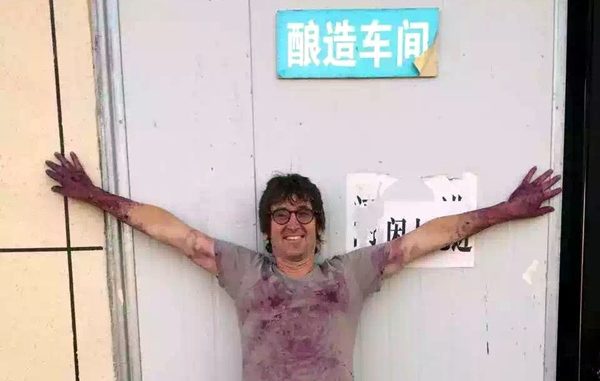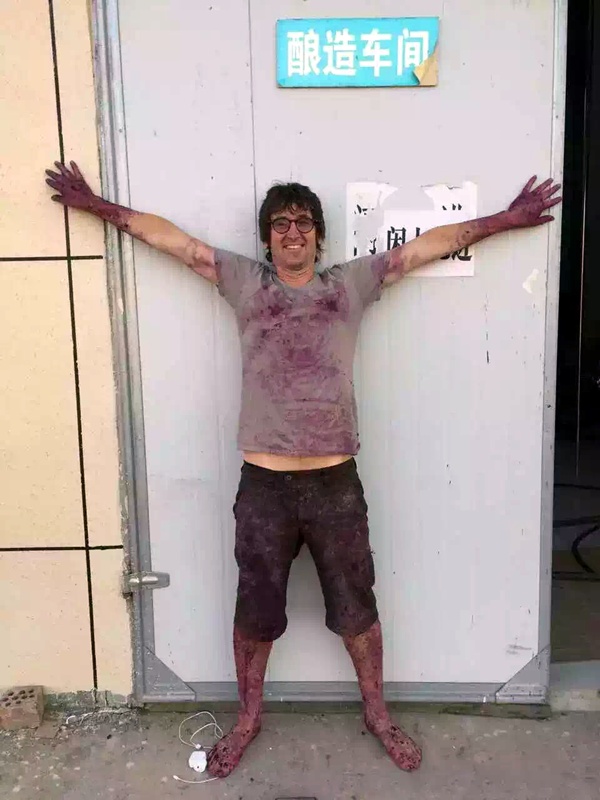
By Jim Boyce | Australian Mike Gadd was among the 48 contestants from 17 nations who joined the two-year Ningxia Winemakers Challenge (NWC) in 2015. He now consults for Ningxia winery WENS and, as drove around the countrywide last month in the company delivery vehicle—woo-hoo!, I interviewed him about the region’s wines, vineyards and more. (Also see Q&As with NWC’s Justin Corrans, Brian Cheeseborough, Gianpaolo Paglia, Nova Cadamatre, Chris Sargeant and Maria Isabel Tapia.)
Boyce: There were 48 competitors in the NWC but only a few are consulting here. Why?
Gadd: I honestly don’t think a lot of the winemakers understood the culture here. I think they expected to be sought after. I think they thought being a consultant here is the same as in their home countries.
What’s the difference between consulting in Ningxia and your home country, Australia?
Ningxia is a young region chasing instant results and fame and medals. A consultant generally gets two years, then if there is no medal, the winery moves on.
In Australia, there is a strong background of understanding the wine industry as a whole. It’s easy to build a relationship and look at a five-year commitment.
Lots of people in Ningxia thought Cabernet Gernischt would be the region’s grape but it seems like the tide has turned.
I think it was going to be Ningxia’s grape because no one else had it and they thought it fit the terroir. But then you find it is kind of green and weedy and doesn’t taste good all the time.
It’s like the cool climate craze in Australia, with planting Cabernet Sauvignon in places like Tasmania, or in Marlborough in New Zealand. I worked on it in Marlborough and it smelled like cooked cabbage. Ten years later, people look at these green wines and say, “What the fuck?” Everyone was trying to be the new world Bordeaux.
You’ve been in Ningxia for the last three vintages. What are the differences?
A lot of people are raving about 2017. I didn’t see a lot of disease pressure in our vineyard but crop yields were about 30 percent higher, so you lose some intensity. Also some fruit didn’t get to full ripeness. Good viticulturists know how to go through and handle that.
For 2016, it was really hot so everything ripened quickly and many winemakers struggled with high sugar. Fermentation stopped for some people and they got sweet 14-percent-alcohol wine. Being an Aussie winemaker, I’m more experienced in dealing with riper fruit. But were there some good wines in 2016? Yes.
2015 was a middle of the road year. Good fruit expression though with some high disease pressure. Good winemakers should have been able to make pretty good wine.
Ningxia wineries tend to go very heavy on oak. Is it too much?
The propensity is to think more oak equals better wines. Are all the wines too oak-y? No. But definitely at the premium end, you find oakier wines.
Just because you have a barrel doesn’t mean you need to use it. It doesn’t necessarily make better wine, just oakier wine. It’s part of being a juvenile region and selling to a juvenile market. Right now, the most important thing in Ningxia is color: they want black wine.
I look at Australia 25 years ago: chardonnay was all about oak and butter and Shiraz was about oak and big fruit. It’s much more refined now.
Another persistent topic when I talk to people in Ningxia is the state of the vineyards. In short, they need a lot of work.
To me, the issues are obvious from the first minute.
I believe you can make great wine in a bathtub, but unless you have the best fruit, you are not going to get there. There is a lack of basic knowledge on pruning, canopy management, nutritional management, and so on.
I believe they believe their own press, that Ningxia is a great region, so they must have great grapes. That reduces the incentive to improve. Most people now have access to good equipment and barrels, so the next big gains in quality will be in the vineyard.
It’s where the most room for improvement lies but progress seems to be slow.
There is a youthful exuberance here about wine, curiosity about the cult of winemaking, about equipment and everything that can make it better. But doing dirty work in the vineyard is not attractive. It’s hard to convince owners to invest a lot of money when there is no face to be gained. You can’t show it off like you can a nice barrel room.
What percentage of clients are going to see the building or the cellar or the fancy wine press? Maybe 0.5 percent. Yet that always gets the emphasis. People in Beijing and Shanghai are going to buy the wine because it tastes good, not because of a cellar.

Follow Grape Wall on Facebook and Twitter. Sign up for the China wine newsletter below. Also check out sibling sites Beijing Boyce and World Baijiu Day.
Grape Wall has no sponsors of advertisers: if you find the content and projects like World Marselan Day worthwhile, please help cover the costs via PayPal, WeChat or Alipay.
Sign up for the free Grape Wall newsletter here. Follow Grape Wall on LinkedIn, Instagram, Facebook and Twitter. And contact Grape Wall via grapewallofchina (at) gmail.com.

Leave a Reply
You must be logged in to post a comment.